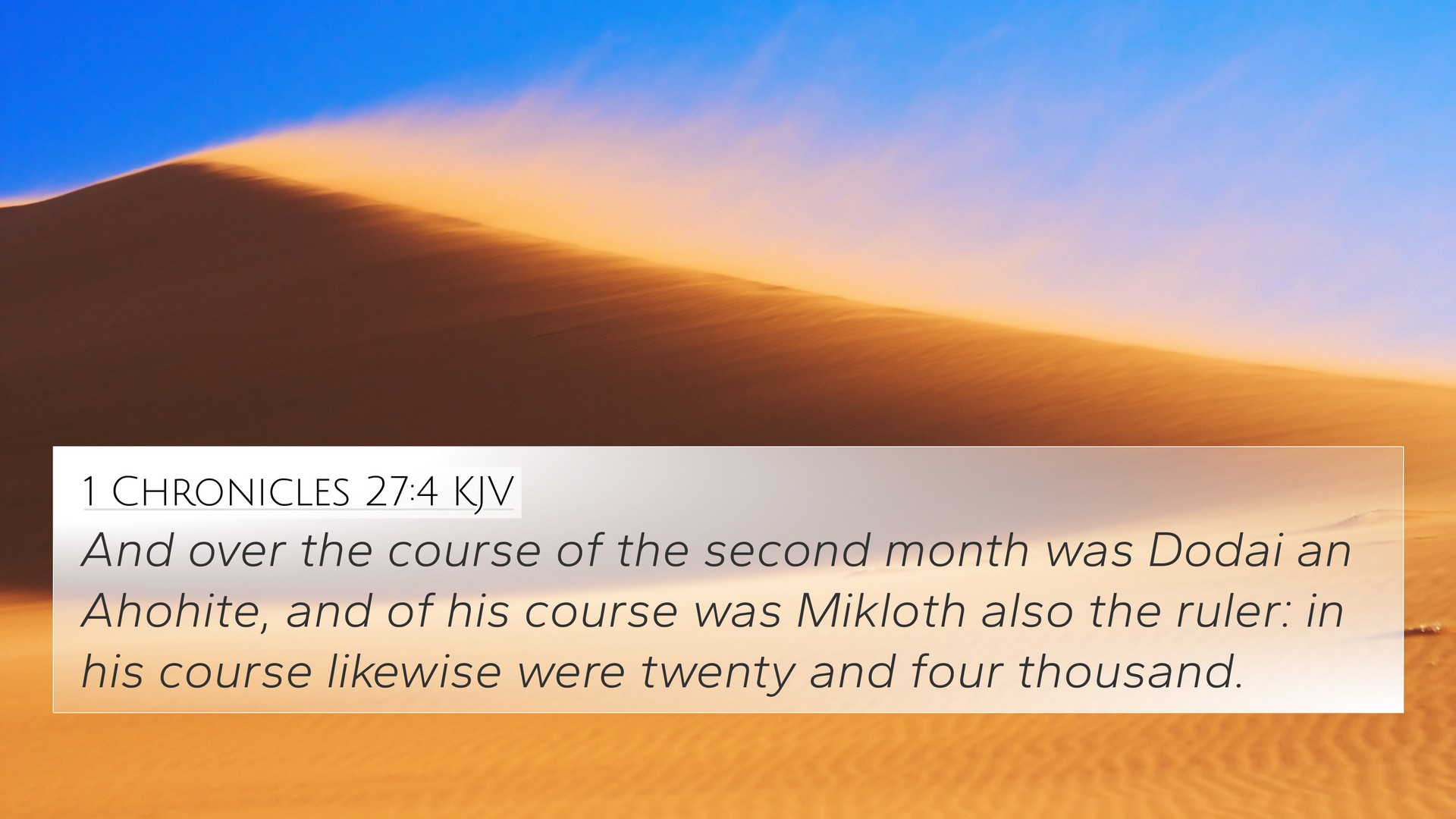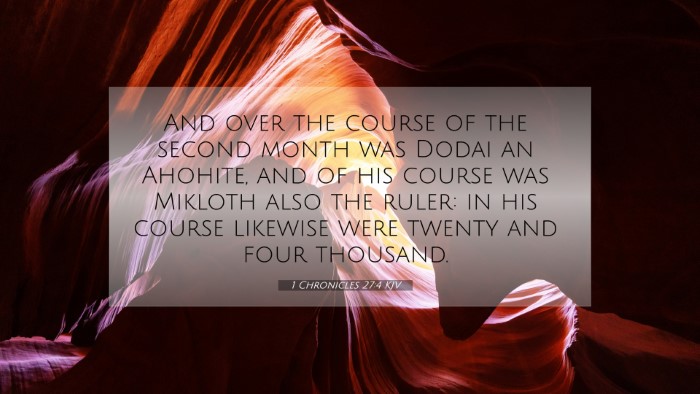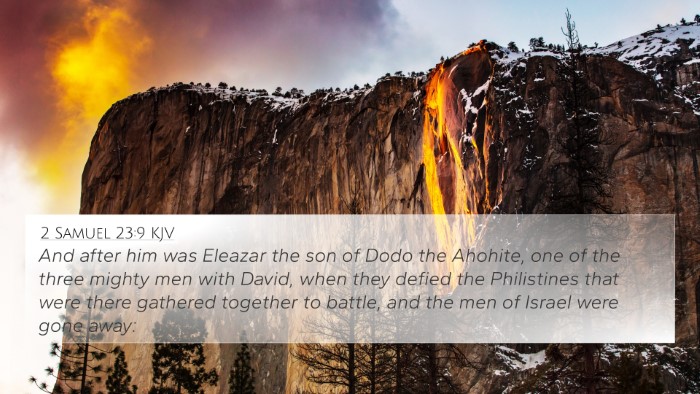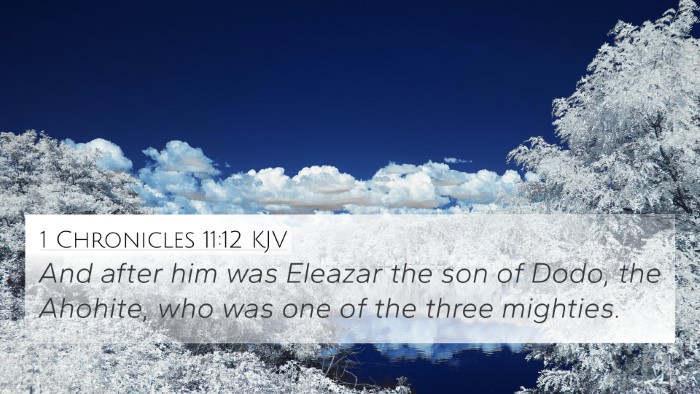Understanding 1 Chronicles 27:4
The verse 1 Chronicles 27:4 states:
"Over the course of the year, David’s army was under the supervision of a commander, whose name was Jashobeam son of Zabdiel. He was the chief of the first division, for the first month; there were twenty-four thousand men in his division." (1 Chronicles 27:4 NIV)
This verse provides a glimpse into the organization of David's military, highlighting the structure under which the Israelite army operated. Here, we delve into a summarized meaning of the verse, incorporating insights from renowned public domain commentators such as Matthew Henry, Albert Barnes, and Adam Clarke.
Context and Structure
The context of 1 Chronicles 27 pertains to King David's administrative setup, particularly the personnel and divisions of his military forces. David established a systematic structure for his army to ensure preparedness and effective governance, reflecting his approach to leadership.
Commentary Insights
-
Matthew Henry:
Matthew Henry notes that David, being a man of war, understood the importance of a well-structured military. The naming of Jashobeam signifies the recognition of leaders who were responsible for different months, emphasizing their role in safeguarding Israel.
-
Albert Barnes:
Albert Barnes highlights that the divisions of the army were organized by months, which ensured a rotation that allowed for rest and efficient management of resources. This text also illustrates the principle of leadership succession and reliability in positions of authority.
-
Adam Clarke:
Adam Clarke indicates that the significance of the number twenty-four thousand suggests a well-maintained military force ready to respond in times of conflict. The structure established by David served as a foundation for military organization in subsequent generations.
Thematic Connections
This verse not only speaks to military organization but imprints broader themes of leadership, governance, and divine order within a nation. The implications of this organization can be explored through various connecting scriptures.
Cross References and Connections
1 Chronicles 27:4 can be cross-referenced with several other verses that highlight similar themes of leadership, organization, and military readiness:
- 2 Samuel 23:8: Describes the mighty men of David and their roles, reflecting on the valor and organization among David's elite troops.
- 1 Chronicles 12:1: Discusses the forces that joined David and the various commanders, showcasing the collaborative nature of leadership.
- Exodus 18:21-22: Insights into the organization of governance and leadership as suggested by Jethro's advice to Moses, relevant to the dynamics of ruling and delegating tasks.
- 1 Timothy 3:1-2: Teaching on church leadership which parallels the necessary qualities of overseers as highlighted in David's military organization.
- Psalm 144:1: Acknowledgment of God as the one who teaches hands to war, emphasizing divine guidance in military affairs.
- 1 Chronicles 28:1: Discusses the assembly of leaders to support David’s plans, underlining the collaborative effort in leadership roles.
- Deuteronomy 1:15: Moses appointing leaders over tribes signifies the necessity of order and structure within the community.
- 1 Corinthians 14:40: Edification on order in worship can draw parallels to the importance of organization in all aspects of community life, including military.
- Romans 13:1: Highlights the importance of authority and governance, affirming God's sovereignty over rulers, similar to David's appointed leaders.
Conclusion
In summary, 1 Chronicles 27:4 serves as a pivotal scripture that sheds light on the administration of King David's army. The insights from public domain commentators elucidate the importance of organization, preparedness, and the spiritual authority underlying leadership. By cross-referencing this verse with other biblical texts, we deepen our understanding of the interconnectedness of scriptural themes pertaining to leadership, governance, and divine order. Thus, we find that this verse is not only about military readiness but also reflects broader principles applicable to various forms of authority and community organization.
Further Study
For those interested in further exploring the links between biblical scripture, utilizing tools for Bible cross-referencing can enhance your understanding. Consider exploring a Bible concordance or a bible cross-reference guide to uncover deeper connections and insights throughout both the Old and New Testaments.




